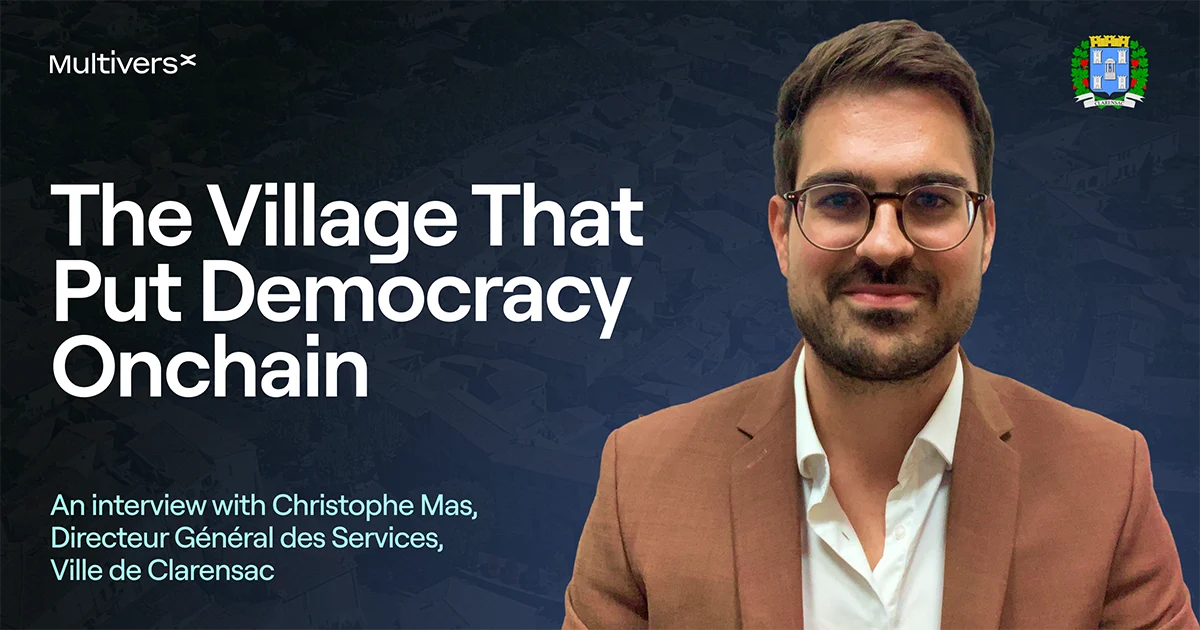

The Village that Put Democracy Onchain
In early October 2025, the small southern French town of Clarensac, nestled among olive groves near Nîmes, quietly made history. Its municipal council became, as far as anyone knows, the first in the world to record official deliberations on a public blockchain.
There were no tokens to trade, no speculation, and no fanfare. Just a handful of administrative documents whose digital fingerprints are now written into the MultiversX ledger—immutable, timestamped, and accessible to anyone. A modest but profound gesture toward transparency in local government.
At the centre of this initiative stands Christophe Mas, the town’s Directeur Général des Services. A jurist by training and a career civil servant, Mas has spent a decade navigating France’s complex legal machinery. His experiment may have opened a new chapter in how administrations secure trust in the digital age.
We spoke with him about how a small town of five thousand inhabitants came to pioneer what he calls “administration 3.0.”

“We wanted a symbol of modernization.”
Christophe Mas:
The idea came from a contradiction I saw every day. In France, municipalities are required to publish deliberations electronically, but we also have to keep bound paper registers to ‘guarantee their integrity’. We’re asked to digitize, yet we still rely on paper to prove authenticity. It made no sense.
I wanted to do something symbolic, something that would demonstrate that integrity and authenticity could be guaranteed digitally. Publishing our deliberations on a public blockchain was the clearest way to do it.
Mas drafted a short note and presented it to Clarensac’s mayor, who approved the plan as a low-risk experiment—a modern addition to the town’s routine administrative practices.
He then reached out to ADAN, the Association for the Development of Digital Assets in Paris. Within days, he was speaking with representatives from France’s Ministry of AI and Digitalization.
Christophe Mas:
They immediately saw the value of the idea as an educational case. It wasn’t about crypto or speculation; it was about trust. Unfortunately, a change in government interrupted our discussions, but by then we were already moving ahead locally.
From full documents to digital fingerprints
Mas’s initial instinct was to upload the full PDF files of council deliberations directly onto the blockchain. Legal research quickly changed his view.
Under the GDPR and French data-protection law, storing personal data on an immutable network is prohibited. A report by Hogan Lovells offered a solution: instead of uploading the files themselves, store a cryptographic hash—a digital fingerprint that proves a file’s integrity without revealing its content.
Christophe Mas:
Using the SHA-256 algorithm, each PDF has a unique signature. We keep the documents on the city’s website, but their hashes and metadata are inscribed on the blockchain. Anyone can verify that a file online is identical to the one approved by the council. If even a comma changed, the hash would be different.
In October, Clarensac recorded four deliberations from its council meeting. One was published as a non-fungible token on xSpotlight, while the others were embedded directly in MultiversX transactions. The total cost of the experiment was €0.02.
Why MultiversX?
Christophe Mas:
I’ve known MultiversX for several years. Over time, I found something special in its community: energy, responsiveness, and real technical depth. It’s also carbon-negative, secure, and extremely affordable. For a public administration, those factors matter.
Mas handled the process himself using xPortal, MultiversX’s digital wallet app, and a browser extension for sending transactions. For someone trained in law rather than computer science, it was a personal experiment in digital learning.
Christophe Mas:
I even used AI tools like ChatGPT to guide me through the steps. I wanted to show that a small municipality, with limited resources, could do this legally, transparently, and cheaply.
Institutional barriers for innovation
The experiment revealed deeper obstacles to digital modernization—ones not technological, but institutional.
Christophe Mas:
The first issue was simple: who pays the gas fee? I paid for it personally, but that’s not sustainable. In France, cities aren’t allowed to hold crypto assets. We need a legal mechanism so municipalities can maintain small balances for transaction fees. Otherwise, even good ideas stall due to our bureaucracy.
He also faced the question of custody—who controls the wallet and how its recovery phrase should be secured.
Christophe Mas:
Today, the wallet is on my work phone. That’s not viable. We need a proper, institutional solution. Ideally, there would be a government portal where civil servants simply upload a document and the system handles the blockchain record automatically. It should be transparent and easy to use, not technical.
An idea that spread overnight
When Mas published a detailed explanation of the project on the town’s website and shared it on social media, the response was immediate.
Christophe Mas:
My phone didn’t stop ringing. I heard from other public officials, engineers, even journalists. Some suggested hosting the documents on decentralized servers; others simply wanted to replicate what we’d done. I was contacted again by the Ministry of AI and Digitalization, and we’re planning a meeting to explore next steps.
Within two days, his post had reached nearly 100,000 views. Clarensac—better known for its vineyards and Roman heritage—suddenly became a reference point for administrative innovation.
Beyond deliberations: towards Administration 3.0
Mas envisions a broader transformation of public governance built on the same principles of traceability and trust.
Christophe Mas:
Citizens care most about how public money is spent. Imagine if every expense above €100,000 were published on the blockchain. Anyone could verify it. That would change the relationship between citizens and their institutions.
He also sees potential in local electronic voting, allowing towns to organize secure, verifiable consultations on community issues.
Christophe Mas:
There’s so much potential, but we need to proceed carefully—experiment, learn, and build confidence step by step. Blockchain should serve democracy, not the other way around.
A small town, a big lesson
Clarensac, quiet and sunlit in the hills west of Nîmes, is now known for more than its history. It has become an example of how public innovation can begin at the smallest scale—not through national decrees, but through initiative, legal curiosity, and a willingness to experiment.
Christophe Mas:
Clarensac is a peaceful town surrounded by history: the Pont du Gard, the Roman arenas of Nîmes. But innovation can start even here, in a small community. The goal is to modernize while staying human.
The lesson is not about technology alone. It is about trust, and the possibility that citizens can verify the integrity of their own institutions. As France and the European Union expand their own blockchain infrastructures, from EBSI to Data.gouv, Clarensac offers a simple reminder: sometimes, transparency begins in a town hall far from Paris—with a civil servant who decided to write his city’s deliberations into digital permanence.
More articles






